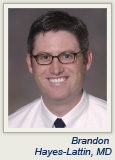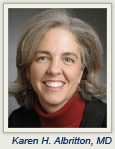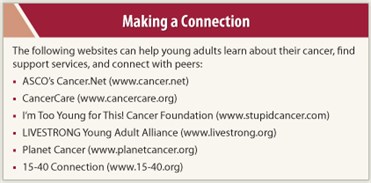While overall cancer survival rates continue to rise-there are nearly 12 million cancer survivors today, according to the latest figures from NCI-most of that improvement is among pediatric and older adult patients. For adolescent and young adult patients with cancer, defined by the NCI as those in the 15- to 39-year-old age range, survival rates have remained stagnant since 1975.  And in certain cancer types, survival rates in this population have actually decreased, making cancer the number one disease-related cause of death in this age group.
And in certain cancer types, survival rates in this population have actually decreased, making cancer the number one disease-related cause of death in this age group.
"Survival is worse for young adults with acute lymphoblastic leukemia (ALL) than it is for children with ALL. Similarly, in breast cancer, survival rates are worse for women under 40 than for older women," saidBrandon Hayes-Lattin, MD, Medical Director, Adolescent and Young Adult Oncology Program, Knight Cancer Institute of Oregon Health & Science University, Portland, and Senior Medical Advisor to the Lance Armstrong Foundation.
Underlying Biology
Although the exact reasons why young adult survivors don't fare as well as other cancer survivors are unknown, clues are starting to emerge. One key factor, say experts, may be that the biology of cancers in young adults is different from the biology of the same diseases in either children or older patients, especially when it comes to the most common cancers diagnosed in young adults, including lymphomas, leukemias, sarcomas, melanoma, and testicular, ovarian, thyroid, colorectal, and breast malignancies.
In 2009, the NCI and the Lance Armstrong Foundation launched a workshop to examine the possible biologic differences in three of those diseases-ALL, breast cancer, and colon cancer-and to discuss ways to improve prognosis and treatment outcomes. The findings were published earlier this year in the Journal of the National Cancer Institute.1 They showed startling differences in the features of these diseases in adolescents and young adults, bolstering the suggestion that tumor biology in these cancers is different compared to the same cancers in the younger and older age groups. For example, young adults diagnosed with colon cancer have more advanced disease  and poorer prognosis at diagnosis compared with older adults, are less responsive to treatment, and have a greater frequency of microsatellite instability.
and poorer prognosis at diagnosis compared with older adults, are less responsive to treatment, and have a greater frequency of microsatellite instability.
"Some of the microsatellite instability is due to the inherited, familial forms of colon cancer, but what we've learned is that microsatellite instability is also found in the nonfamilial types and, therefore, young adults who have no inherited predisposition to cancer who get colon or rectal cancer probably often have a different molecular type than occurs in older persons. That a majority of young adults who develop colon cancer have sporadic disease and the microsatellite instability type is a clear illustration that a distinctly different biologic type is involved," saidArchie W. Bleyer, MD, Clinical Research Professor, Oregon Health & Science University, and Co-Chair of the Research Task Force of the LIVESTRONG Young Adult Alliance.
Different Standards of Care?
The clinical features of breast cancer and ALL in young adults are also worse, including more aggressive disease and less favorable outcomes, which may mean that cancers in this age group need different treatment protocols. The NCI's Adolescent and Young Adult Oncology Progress Review Group has recommended the development of standards of care for young adults, and both the National Comprehensive Cancer Network and the LIVESTRONG Young Adult Alliance are working on developing standards of care. However, the availability of clinical trials for this age group is limited and participation in clinical trials by adolescent and young adult patients is lacking-only 5% of 15 to 25 year olds are entered into clinical trials compared to 60% to 65% of younger patients. Given the resulting insufficiency of tissue specimens, these factors make it difficult to study the possible molecular differences of young adult tumors and how those differences impact treatment effectiveness.
 Body composition, size, organ maturity, and hormonal status may also be contributing factors in stagnating survival rates among young adults.
Body composition, size, organ maturity, and hormonal status may also be contributing factors in stagnating survival rates among young adults.
"There's probably a biologic reason; age is just a surrogate," saidKaren H. Albritton, MD, Director, Adolescent and Young Adult Oncology Program, Cook Children's Medical Center and University of North Texas Health Science Center in Fort Worth. "It may be the biology of the tumor, the biology of the host, hormonal differences, or that adolescents and young adults are using substances that affect their drug metabolism. It's just a hypothesis, but these patients may be different because of their changing body metabolism and fat distribution, and we may be missing the mark a lot."
Compliance Issues
Lack of treatment compliance may also play a role in worse survival outcomes. According to research published last year in the Journal of Clinical Oncology,2 as many as 27% to 60% of young people may have poor adherence to cancer treatment. And those percentages are expected to rise with the advent of more oral cancer drugs.
"Anecdotally, we all recognize that there could be a major issue with compliance, but I think the problem is underrecognized. We don't have enough data to point to how common and critical the problem is. I know that for chronic myelogenous leukemia, for which the treatment is the oral medication imatinib (Gleevec), studies have looked at the degree to which patients of all ages aren't able to adhere to a regular schedule, as well as the fact that missing just a handful of doses a month can lead to differences in cytogenetic outcomes," said Dr. Hayes-Lattin.
 Although no definitive data have shown cause and effect, delays in seeking medical treatment and getting an accurate diagnosis may also be sabotaging survival rates. "We think a couple of things could be contributing to these differences in survival. One is basic biology. The second is how people react to the health-care system, and that includes a delayed diagnosis, which can be quite common in young adult cancers, in part because the patients themselves don't consider cancer when they have a nagging medical condition, but also because providers don't consider cancer in young patients either," said Dr. Hayes-Lattin. While a delayed diagnosis may not ultimately alter the outcome of disease for young adult patients, it may mean that they need more intense treatment, which could result in more late and long-term effects, including secondary cancers, infertility, fatigue, depression, and cognitive problems, hindering quality of life for a population with potentially decades more to live.
Although no definitive data have shown cause and effect, delays in seeking medical treatment and getting an accurate diagnosis may also be sabotaging survival rates. "We think a couple of things could be contributing to these differences in survival. One is basic biology. The second is how people react to the health-care system, and that includes a delayed diagnosis, which can be quite common in young adult cancers, in part because the patients themselves don't consider cancer when they have a nagging medical condition, but also because providers don't consider cancer in young patients either," said Dr. Hayes-Lattin. While a delayed diagnosis may not ultimately alter the outcome of disease for young adult patients, it may mean that they need more intense treatment, which could result in more late and long-term effects, including secondary cancers, infertility, fatigue, depression, and cognitive problems, hindering quality of life for a population with potentially decades more to live.
"We have to think about the definition of quality of life for young adults and balance treatment toxicity [accordingly]," said Dr. Albritton. "We have to meet young adults where they're at. The field of oncology has moved to a place where we are curing more people, and we were trained to go for the cure, assuming that patients would do anything for that. We imagined they would come back to us 20 years later and say, 'I don't care if I can't have kids and I can't have a normal life-I'm alive.' But those days are gone. We owe more to our patients. We can do more than just cure them, and I think we have to take into account these quality-of-life issues, especially for adolescents and young adults who, hopefully, have 50 years ahead of them, not 5."
Raising Awareness
To help educate medical professionals-especially those at the front line of care for young adults, including primary care physicians and nurses-on the challenges of diagnosing and treating young adult patients with cancer, ASCO partnered with LIVESTRONG to launch a new ASCO University® program called Focus Under Forty™ (http://university.asco.org/focusunder40). To improve survival rates in this population, adolescents and young adults themselves will also need to be educated on the risks and symptoms of cancer.
"Educating young people about cancer is hard because twenty-somethings don't want to hear about cancer. They're invincible at that age, and education has to be done smartly and nonthreateningly," said Dr. Albritton. "ASCO members can look for opportunities to do this type of education, to speak to high school and college students, for example, and at medical conferences for primary care physicians [to alert them to the risks and symptoms of cancer in this age group]." ■
Financial Disclosure: Dr. Bleyer is on the speakers bureau and a consultant for Sigma-Tau Pharmaceuticals. Dr. Albritton reported no potential conflicts of interest.
Reference
1. Tricoli JV, Seibel NL, Blair DG, et al: Unique characteristics of adolescent and young adult acute lymphoblastic leukemia, breast cancer and colon cancer. J Natl Cancer Inst 103:628-635, 2011.
2. Butow P, Palmer S, Pai A, et al: Review of adherence-related issues in adolescents and young adults with cancer. J Clin Oncol 28:4800-4809, 2010.

 Each year in the United States, approximately 70,000 people between the ages of 15 and 40 are diagnosed with cancer. And while getting a cancer diagnosis at any age can be devastating, for adolescents and young adults (AYAs) grappling with sexuality, body image, peer pressure, dating, marriage,...
Each year in the United States, approximately 70,000 people between the ages of 15 and 40 are diagnosed with cancer. And while getting a cancer diagnosis at any age can be devastating, for adolescents and young adults (AYAs) grappling with sexuality, body image, peer pressure, dating, marriage,...